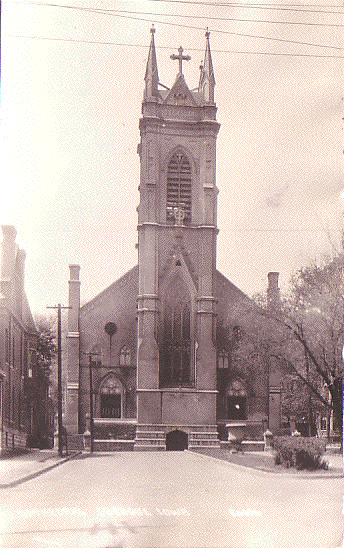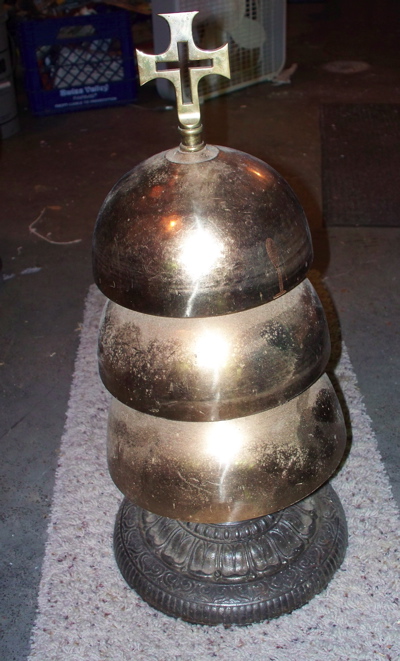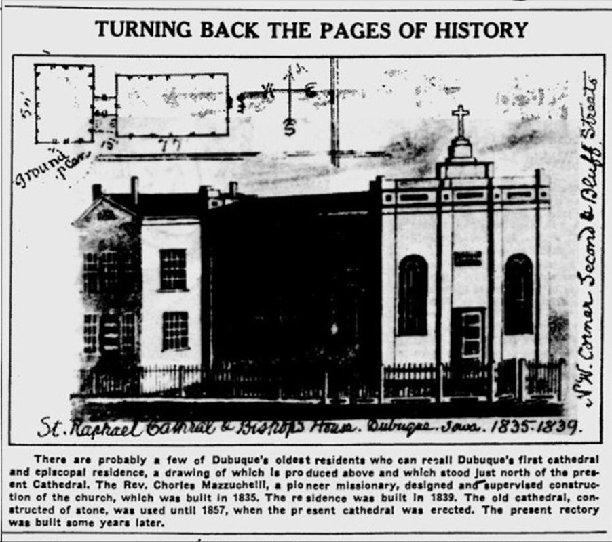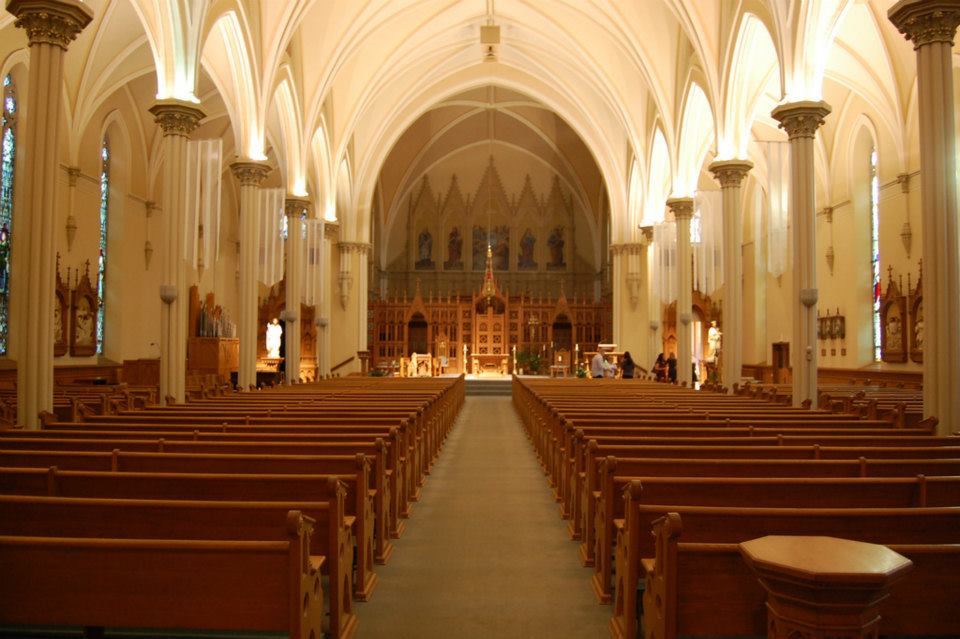Encyclopedia Dubuque
"Encyclopedia Dubuque is the online authority for all things Dubuque, written by the people who know the city best.”
Marshall Cohen—researcher and producer, CNN
Affiliated with the Local History Network of the State Historical Society of Iowa, and the Iowa Museum Association.
ST. RAPHAEL'S CATHEDRAL: Difference between revisions
No edit summary |
No edit summary |
||
| Line 14: | Line 14: | ||
St. Raphael's tower and spire were completed in November 1876. Stained glass windows imported from London were installed in 1889. A mortuary chapel built beneath the floor in front of the altar holds three vaults containing the bodies of Bishop Loras, Bishop [[SMYTH, Clement|Clement SMYTH]], and Archbishop [[HENNESSY, John|John HENNESSY]]. Major renovations in the cathedral were made during 1886, 1914, and 1936. | St. Raphael's tower and spire were completed in November 1876. Stained glass windows imported from London were installed in 1889. A mortuary chapel built beneath the floor in front of the altar holds three vaults containing the bodies of Bishop Loras, Bishop [[SMYTH, Clement|Clement SMYTH]], and Archbishop [[HENNESSY, John|John HENNESSY]]. Major renovations in the cathedral were made during 1886, 1914, and 1936. | ||
In June 1986 renovation plans for St. Raphael's Cathedral were approved by Roman Catholic officials. Work was scheduled to begin on July 7. Parish rector Rev. John Dalton announced that it had been nearly fifty years since the interior of the church had been refurbished. The priorities for the project included enhancing the devotional and sacramental areas of the church while maintaining the [[GOTHIC REVIVAL ARCHITECTURE]]. Dividers between the pews were scheduled to be removed to eliminate a fire hazard. The walls were to be painted a lighter color, lighting was to be installed to focus attention on the vaulted ceiling, and the wooden trim was to be bleached to return it to its original color. The floor was to be carpeted and the murals cleaned. | [[File:STR.jpg|200px|thumb|left|Photo courtesy: https://www.facebook.com/pages/You-know-you-grew-up-in-Dubuque-Iowa-if-you-remember/130170407077838]]In June 1986 renovation plans for St. Raphael's Cathedral were approved by Roman Catholic officials. Work was scheduled to begin on July 7. Parish rector Rev. John Dalton announced that it had been nearly fifty years since the interior of the church had been refurbished. The priorities for the project included enhancing the devotional and sacramental areas of the church while maintaining the [[GOTHIC REVIVAL ARCHITECTURE]]. Dividers between the pews were scheduled to be removed to eliminate a fire hazard. The walls were to be painted a lighter color, lighting was to be installed to focus attention on the vaulted ceiling, and the wooden trim was to be bleached to return it to its original color. The floor was to be carpeted and the murals cleaned. | ||
Work started on the project despite the protests of the Save Our Cathedral Committee whose members claimed the work would destroy the historical significance of the building. One of the most controversial decisions led to the construction of entrances into the cathedral where side altars had once stood. The pews were refinished to remove years of varnish and allow the light oak beneath to show. The remains of [[SAINT CESSIANUS]] were installed in the altar during the first mass in the new surroundings held on November 23, 1986. | Work started on the project despite the protests of the Save Our Cathedral Committee whose members claimed the work would destroy the historical significance of the building. One of the most controversial decisions led to the construction of entrances into the cathedral where side altars had once stood. The pews were refinished to remove years of varnish and allow the light oak beneath to show. The remains of [[SAINT CESSIANUS]] were installed in the altar during the first mass in the new surroundings held on November 23, 1986. | ||
Revision as of 02:15, 22 June 2013
ST. RAPHAEL'S CATHEDRAL. Dominant landmark in downtown Dubuque along the bluffs. The cathedral parish was organized by Father Charles Felix Van Quickenborne in July of 1833, soon after LEAD miners founded the village of "Dubuque's Mines." Father Quickenborne immediately began planning for the construction of a church but left before the materials were assembled.
In 1834 Father Charles Francis Fitzmaurice, an Irishman educated in Paris, arrived in Dubuque and gathered the materials and money. He died of CHOLERA in the spring of 1835 without starting the actual construction of the church.
In 1835 with the arrival of Father Samuel MAZZUCHELLI, a Dominican missionary, the tiny parish was reorganized. A church was finally erected, not of logs as Father Quickenborne had planned but of stone. To save the cost of an architect, Father Mazzuchelli drew the plans for the church and named the building Saint Raphael's Church after one of the three archangels.
In 1839 Father Mazzuchelli directed the construction of a large building at the back of the cathedral. This structure served the bishop and was used to house Saint Raphael's Seminary, lowa’s first diocesan college.
In 1845 Bishop Loras, faced with the crowded condition of the cathedral, planned the construction of a new church in the center of the downtown area. A cornerstone was laid in 1849, but work never proceeded past the laying of the foundation. Formation of Holy Trinity parish (now St. Mary's) in 1849 and St. Patrick's parish in 1853 relieved overcrowding. Realizing that this was only a temporary solution, Bishop Loras again planned a new cathedral.
Work began in 1857 on land adjacent to the stone church built by Father Mazzuchelli. The cathedral, modeled from Magdalen College in Oxford, England, was designed by John Mullany, a local architect. A huge audience witnessed the laying of the cornerstone on Sunday, July 5, 1857. Completed in 1861 the cathedral, over three times larger than its predecessor, witnessed its first Mass, offered by Bishop Loras two months before his death, on Christmas 1857. The cathedral received its formal dedication and blessing on July 7, 1861.
St. Raphael's tower and spire were completed in November 1876. Stained glass windows imported from London were installed in 1889. A mortuary chapel built beneath the floor in front of the altar holds three vaults containing the bodies of Bishop Loras, Bishop Clement SMYTH, and Archbishop John HENNESSY. Major renovations in the cathedral were made during 1886, 1914, and 1936.
In June 1986 renovation plans for St. Raphael's Cathedral were approved by Roman Catholic officials. Work was scheduled to begin on July 7. Parish rector Rev. John Dalton announced that it had been nearly fifty years since the interior of the church had been refurbished. The priorities for the project included enhancing the devotional and sacramental areas of the church while maintaining the GOTHIC REVIVAL ARCHITECTURE. Dividers between the pews were scheduled to be removed to eliminate a fire hazard. The walls were to be painted a lighter color, lighting was to be installed to focus attention on the vaulted ceiling, and the wooden trim was to be bleached to return it to its original color. The floor was to be carpeted and the murals cleaned.
Work started on the project despite the protests of the Save Our Cathedral Committee whose members claimed the work would destroy the historical significance of the building. One of the most controversial decisions led to the construction of entrances into the cathedral where side altars had once stood. The pews were refinished to remove years of varnish and allow the light oak beneath to show. The remains of SAINT CESSIANUS were installed in the altar during the first mass in the new surroundings held on November 23, 1986.
Stretching eastward in front of the cathedral is a pedestrian plaza developed through the work of Msgr. Norbert C. Barrett, pastor of St. Raphael's in 1975 and Wayne Andrew NORMAN, Sr. Gracing the plaza is the sculpture FIVE FIGURES FOR FIVE FLAGS. The work, featuring a steamboat captain, LEAD miner, frontier farmer and his wife, originally included a lumberjack. At the request of Norman and Msgr. Barrett, this figure was replaced with the figure of a missionary priest. The sculpture was one of the four finalists in the 1973 Five Flags Sculpture Contest eventually won by CONTINUUM.
---
Source:
175 Years, Volume 2, "A Tour of Dubuque's Landmarks," Telegraph Herald, June 23, 2008





